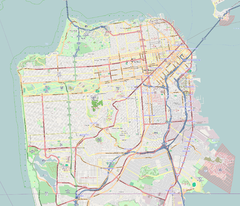City of Paris Dry Goods Co.
This article includes a list of general references, but it lacks sufficient corresponding inline citations. (April 2009) |
| City of Paris Dry Goods Company | |
|---|---|
 Motto of the City of Paris | |
 The building in 1909 | |
| Alternative names | City of Paris |
| General information | |
| Status | Demolished 1980 |
| Type | department store |
| Architectural style | Beaux-Arts |
| Address | 150 Stockton Street |
| Town or city | San Francisco, California |
| Country | United States |
| Coordinates | 37°47′15″N 122°24′23″W / 37.787432°N 122.406464°W |
| Opened | 1896 |
| Closed | 1981 |
| Design and construction | |
| Architect(s) | Clinton Day |
| NRHP reference No. | 75000471 |
| Added to NRHP | January 23, 1975 |
The City of Paris Dry Goods Company (later City of Paris) was one of San Francisco's important
Origins

The store's history is rooted in the 1849
The store's final and best-known location was a Beaux-Arts building designed by architect Clinton Day, built in 1896 on the corner of Geary and Stockton streets across from Union Square.[3]
The Verdier family initially created a famous restaurant in Paris in 1839 La Maison Dorée by Louis Verdier and then the Etablissements Gaston Verdier (textile industry in France).[4]
Branches and offshoots
The San Diego branch of the City of Paris opened in 1886 in the Bancroft Building on the southeast corner of Fifth and G Streets in what is now the Gaslamp Quarter. The building was designed by San Francisco architect Clinton Day.[5]
In the 1940s, City of Paris opened a branch in the outlying Vallejo, California, and other locations around the Bay Area.
French emigre Auguste Fusenot (French Consul in Los Angeles 1898–1907)
There was also an unrelated City of Paris (Los Angeles) dry goods emporium from 1874 to 1897.
San Francisco earthquake
The building was one of the few in the neighborhood to survive the
The City of Paris maintained a connection with French culture reflected in the store's décor and merchandise. The Verdier Cellars stocked many fine French vintages and was the most extensive wine department of any American department store. At the time of Prohibition, the lower level of the store was redesigned as a French village and named Normandy Lane. This concept was borrowed by the across the street neighbor Macy's California where the store's lower level was similarly transformed and named Macy's Cellar. Macy's Cellar was installed in other Macy divisions' locations. In 1961, when Julia Child and Simone Beck were promoting their just published Mastering the Art of French Cooking, they spent an entire day at the store doing cooking demonstrations. The bookseller Brentano's opened a branch within the City of Paris store; it became the largest bookstore west of Denver.
The City of Paris had multiple branch stores in the San Francisco Bay Area:
Closure

The City of Paris remained under the ownership and management of the Verdier family until it closed in March 1972. The store was not bankrupt, but it was losing money. The store building was purchased by
References
- ^ a b c d Paul Goldberger (1983-11-13). "San Franciscans get three new buildings". New York Times.
- ^ Généalogie Verdier https://gw.geneanet.org/asimoneton_w?lang=en&m=N&v=VERDIER
- ^ a b "California State Historical Landmarks in San Francisco County". State of California, California Resources Agency, California Environmental Resources Evaluation System. Archived from the original on 2009-01-09. Retrieved 2009-01-02.
- user-generated source]
- ISBN 978-0962578809.
- ^ "The Grizzly Bear". 1917.
- ^ "Ville de Paris 1901". Calisphere, University of California Library. Archived from the original on 9 September 2018. Retrieved 9 Sep 2018.
- ^ "City of Paris Dry Goods Co., San Francisco, California". The Department Store Museum. Archived from the original on 9 July 2016. Retrieved 18 July 2023.
Sources
- Birmingham, Nan Tilson, Store, copyright 1978, ISBN 0-399-11899-3
- Hendrickson, Robert, The Grand Emporiums, copyright 1980, ISBN 0-8128-6092-6
- Wilson, Carol Green, Gump's Treasure Trade, copyright 1949
- Child, Julia, My Life in France, copyright 2006, page 233, ISBN 1-4000-4346-8
- Mahoney, John & Sloane, Leonard, The Great Merchants, copyright 1966, page 142
- Powell, Edith Hopps, San Francisco's Heritage in Art Glass, copyright 1976, ISBN 0-87564-013-3
- Whitaker, Jan, Service and Style, copyright 2006, ISBN 0-312-32635-1
- Reilly, Philip J.,Old Masters of Retailing, copyright 1966
External links
 Media related to City of Paris building at Wikimedia Commons
Media related to City of Paris building at Wikimedia Commons



